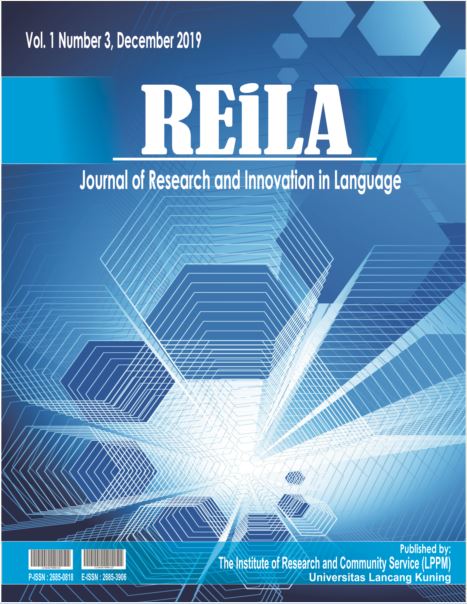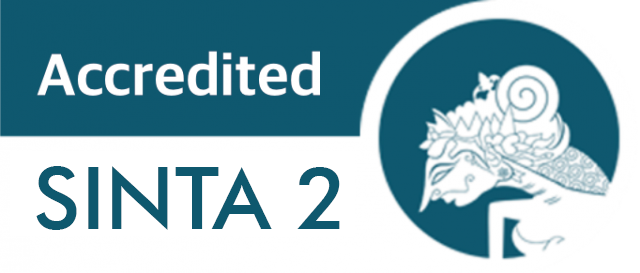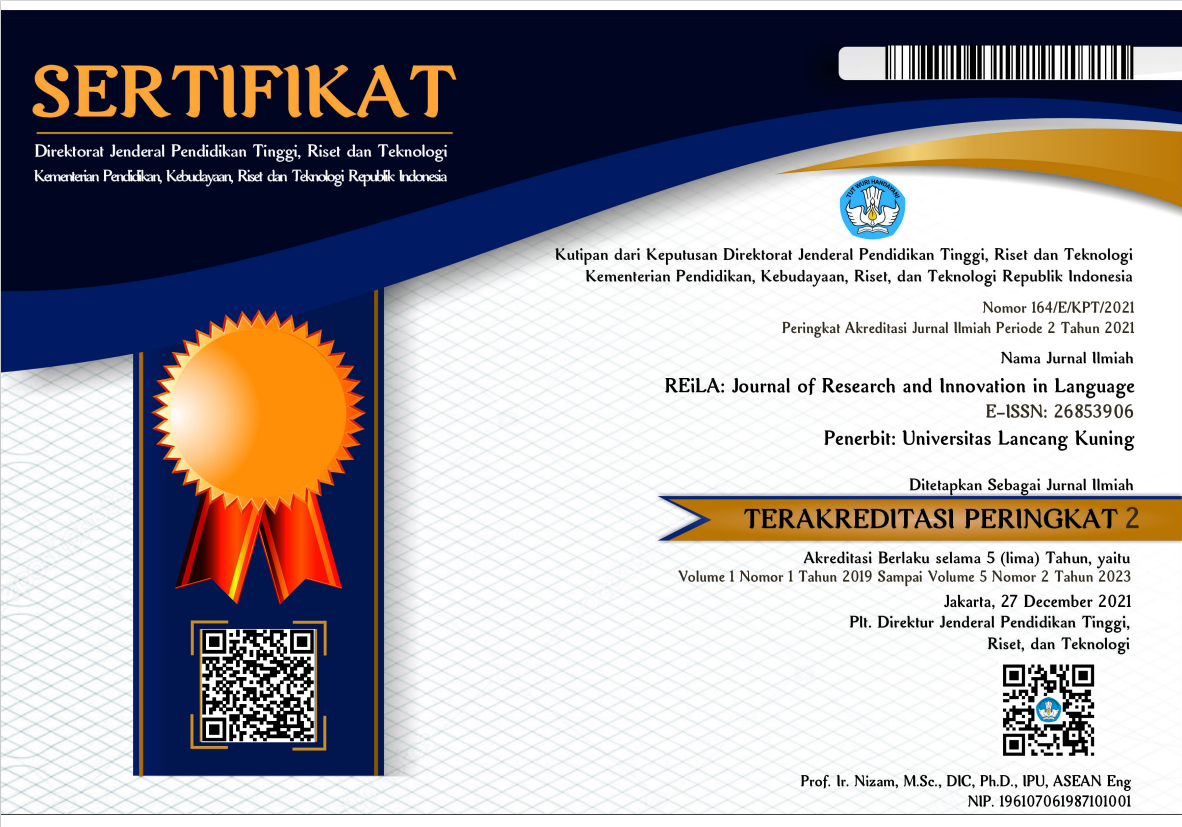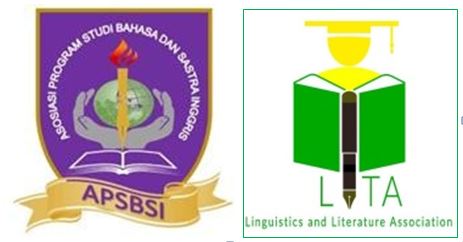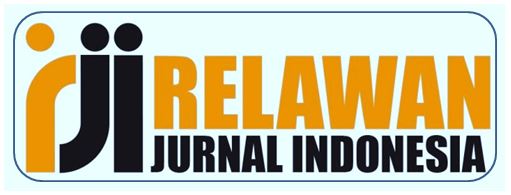Re-Visits the Grand Theory of Geoffrey Leech: Seven Types of Meaning
Abstract
Meaning is the field of the study discussed in semantic science. Semantics is a branch of linguistics that studies the meaning of words in languages. In contrast, linguistics is the study of oral and written communications that have systematic, rational, empirical characteristics as a description of the structure and rules of language. This present study argues that the meaning of a word in language can be known with the foundation of semantic science. The problems this present study focused on are the seven types of meaning and their descriptions in the book of Semantics by Geoffrey Leech: 1981. The research aims to classify and to identify seven types of meanings, and also to analyze Leech’s book and three article reviews of his theory. This present study uses a qualitative approach focusing on the words, phrases, and sentences regarding the theory. The result of this research confirmed that there are seven types of meaning based on Leech’s theory, namely conceptual, connotative, collocative, reflective, affective, social, and thematic. A novelty that this present study found is that the seven types of meaning have variations in their descriptions.
Downloads
References
Umagandhi, R., & Vinothini, M. (2017). Leech’s seven types of meaning in semantics. International Journal of Multidisciplinary Research and Development, 4.
Bloomfield. 1933:139. Language. New York: Compton Printing LTD. Cann, Ronnie. 1994. Formal Semantics. New York: Cambridge University Press. Chaer, Abdul. 1990. Pengantar Semantik Bahasa Indonesia. Jakarta: Rineka Cipta Djajasudarma, Fatimah. 2009. Semantik 2 Pemahaman Ilmu Makna. Bandung: Refika Aditama 2009.
Crystal, D. 1987. The Cambridge Encyclopedia of Language. Melbourne, Australia: Cambridge University Press.
Crystal, D. 1991. A Dictionary Of Linguistics and Phonetics 3rd Edition. Cambridge, MA: Bsil Blackwell.
Dingxiasong. 1998. The understanding of the slogans/taglines. E-Journal on-line. 23 April 2010. [email protected]
Dutamurty. E. N. 2013. Associative Meaning on www.khilafah.com. Surabaya: Surabaya State University.
Hurford, James., Heasley, Brendan., and Smith, Michael. 2007. Semantics a Course Book. Second ed. New York. Cambridge Press.
Jindal, D.V and Syal, Pushpinder. 2002. An Introduction To Linguistics: Language Grammar and Semantics. New Delhi: Asoke K. Ghosh
Kridalaksana, Harimukti. 2008. Kamus Linguistik: Introduction to Theoretic Linguistics. Jakarta: PT Gramedia.
Leech, G. 1974. Semantics. New York, U.S.A: Penguin.
Leech, G. 1974. Semantik. Translated by Paina Partana. 2003. Yogyakarta: Pustaka Pelajar.
Leech, Geoffrey. 1981. Semantics The Study of Meaning. Second ed. Great Britain:Penguin Books.
Lyons, J. 1997. Semantics Volume I. Great Britain: University Press, Cambridge.
Morley, G, D. 2000. Syntax IN Functional Grammar: An Introduction to Lexicogrammar in systematic Linguistics. New York: Continum.
Noor, M. and Mustafa, R and Muhabat, F and Kazemian, B. 2015. The Language of TV Commercials’ Slogans: A Semantic Analysis. Pakistan: University of Gujrat, Punjab. Vol. 1, pp 7-12
Sarefah, L. 2008. The Associative Meaning in The Headlines of The Jakarta Post. Unpublished Thesis. The State Islamic University of Malang.
Wheeler, A. 2003. Designing Brand Identitiy: A Complete Guide to Creating, Building and Maniatining Strong Brands. John Wiley and Sons.
Wiryanti, S. 2015. Associative Meaning of Pornography in Printed Media Advertising Products: A Pragmatic Study. Surakarta: Sebelas Maret University of Surakarta. Vol.36: 370.
Yusuf, N, L. 2010. A Study on The Associative Meanings of The Jakarta Weekender Magazine. Unpublished Thesis. Maulana Malik Ibrahim State Islamic University of Malang
Hussein, H. A. H. (2017). Types of Meaning Exploited in Advert's Textuality: A semantic approach. Journal of Al_Anbar University for Language and Literature, (25), 170-185.
Maisel, T., & Lexicology, P. S. (2018). The Meaning of Meaning: Leech’s Seven Types of Meaning in Comparison to Palmer’s and Lyons’ Approaches.
Michaud, M. (2017). On Collocative Meaning. Journal of semantics and EFL.
Harefa, D. K., & Ginting, I. (2018). Associative meaning of hendihendi in giving afo in nias wedding ceremony. The episteme Journal of linguistics and literature, 4(3).
Maroon, I. (2018). A Semantic Analysis of Lyrics Expression (Doctoral Dissertation, Universitas Muhammadiyah Surakarta).
Abdelaal, N. M. (2018). Translating connotative meaning in the translation of the Holy Quran: Problems and solutions. AWEJ for Translation & Literary Studies, Volume2, (1).
Altstiel, T and Grow, J. 2008. Advertising Strategy (Creative Tactics from the Outside/In). Singapore: Seng Lee Press Pte. Ltd.
Hussein, H. A. H. (2017). Types of Meaning Exploited in Advert's Textuality: A semantic approach. Journal of Al_Anbar University for Language and Literature, (25), 170-185.
Wangru, C. (2016). Vocabulary Teaching Based on Semantic-Field. Journal of Education and Learning, 5(3), 64-71.

